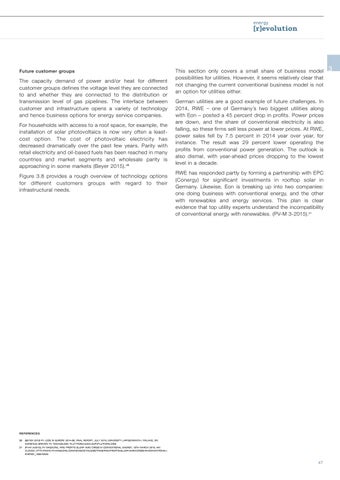energy
[r]evolution
future customer groups
The capacity demand of power and/or heat for different customer groups defines the voltage level they are connected to and whether they are connected to the distribution or transmission level of gas pipelines. The interface between customer and infrastructure opens a variety of technology and hence business options for energy service companies. for households with access to a roof space, for example, the installation of solar photovoltaics is now very often a leastcost option. The cost of photovoltaic electricity has decreased dramatically over the past few years. Parity with retail electricity and oil-based fuels has been reached in many countries and market segments and wholesale parity is approaching in some markets (beyer 2015). 20 figure 3.8 provides a rough overview of technology options for different customers groups with regard to their infrastructural needs.
This section only covers a small share of business model possibilities for utilities. However, it seems relatively clear that not changing the current conventional business model is not an option for utilities either. German utilities are a good example of future challenges. In 2014, RWE – one of Germany’s two biggest utilities along with Eon – posted a 45 percent drop in profits. Power prices are down, and the share of conventional electricity is also falling, so these firms sell less power at lower prices. At RWE, power sales fell by 7.5 percent in 2014 year over year, for instance. The result was 29 percent lower operating the profits from conventional power generation. The outlook is also dismal, with year-ahead prices dropping to the lowest level in a decade. RWE has responded partly by forming a partnership with EPC (Conergy) for significant investments in rooftop solar in Germany. Likewise, Eon is breaking up into two companies: one doing business with conventional energy, and the other with renewables and energy services. This plan is clear evidence that top utility experts understand the incompatibility of conventional energy with renewables. (Pv-M 3-2015). 21
references 20 21
(bEyER 2015) Pv LCOE IN EuROPE 2014-30; fINAL REPORT, juLy 2015; uNIvERSITy LAPPEENRANTA / fINLAND, DR. CHRISTIAN bREyER; Pv TECHNOLOGy PLATTfORM;WWW.EuPvPLATfORM.ORG (Pv-M 3-2015); Pv MAGAzINE, RWE PROfITS SLuMP AMID CRISIS IN CONvENTIONAL ENERGy; 10TH MARCH 2015; IAN CLOvER; HTTP://WWW.Pv-MAGAzINE.COM/NEWS/DETAILS/bEITRAG/RWE-PROfITS-SLuMP-AMID-CRISIS-IN-CONvENTIONALENERGy_100018539.
47
3
